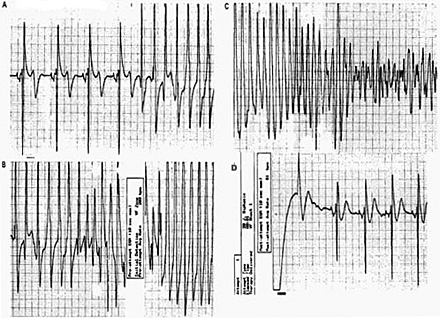
Figure 61
Stored Ventricular Electrogram from an
Asymptomatic 35-Year-Old Man Who Received a Defibrillator Prophylactically
Because of a Family History of Sudden Death Related to Hypertrophic
Cardiomyopathy and Marked Ventricular Septal Thickness (31mm).
The electrogram was obtained four years eight
months after implantation of the defibrillator. The data were recorded
at 1:20 a.m. while the patient was asleep. A continuous recording, at
25mm per second, is shown in four panels, with the tracing recorded
from left to right in each. After four beats of sinus rhythm, ventricular
tachycardia begins abruptly, at a rate of 200 beats per minute (Panel
A). The defibrillator senses ventricular tachycardia and charges (Panel
B). Ventricular tachycardia deteriorates into ventricular fibrillation
(Panel C). The defibrillator discharges appropriately (a 20-J shock
denoted by the bar, Panel D) during ventricular fibrillation and restores
sinus rhythm. Adapted from Maron et al.
Maron, B.J., M.D., and others, Efficacy of Implantable Caridoverter-Defibrillators For The Prevention of Sudden Death in Patients with Hypertrophic Cardiomyopathy, The New England Journal of Medicine, Feb 10, 2000, p 365-373.